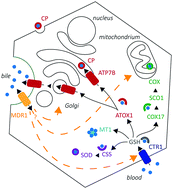当前位置:
X-MOL 学术
›
Metallomics
›
论文详情
Our official English website, www.x-mol.net, welcomes your
feedback! (Note: you will need to create a separate account there.)
Downregulation of hepatic multi-drug resistance protein 1 (MDR1) after copper exposure
Metallomics ( IF 2.9 ) Pub Date : 2017-07-31 00:00:00 , DOI: 10.1039/c7mt00189d Sara Reinartz Groba 1, 2, 3, 4 , Sarah Guttmann 1, 2, 3, 4 , Christoph Niemietz 1, 2, 3, 4 , Friedrich Bernick 1, 2, 3, 4 , Vanessa Sauer 1, 2, 3, 4 , Oliver Hachmöller 4, 5, 6, 7 , Uwe Karst 4, 5, 6, 7 , Hans Zischka 4, 8, 9, 10, 11 , Andree Zibert 1, 2, 3, 4 , Hartmut H. Schmidt 1, 2, 3, 4
Metallomics ( IF 2.9 ) Pub Date : 2017-07-31 00:00:00 , DOI: 10.1039/c7mt00189d Sara Reinartz Groba 1, 2, 3, 4 , Sarah Guttmann 1, 2, 3, 4 , Christoph Niemietz 1, 2, 3, 4 , Friedrich Bernick 1, 2, 3, 4 , Vanessa Sauer 1, 2, 3, 4 , Oliver Hachmöller 4, 5, 6, 7 , Uwe Karst 4, 5, 6, 7 , Hans Zischka 4, 8, 9, 10, 11 , Andree Zibert 1, 2, 3, 4 , Hartmut H. Schmidt 1, 2, 3, 4
Affiliation

|
Copper homeostasis is strictly regulated in mammalian cells. We investigated the adaptation of hepatocytes after long-term copper exposure. Copper-resistant hepatoma HepG2 cell lines lacking ATP7B were generated. Growth, copper accumulation, gene expression, and transport were determined. Hepatocyte-like cells derived from a Wilson disease (WD) patient and the liver of a WD animal model were also studied. The rapidly gained copper resistance was found to be stable, as subculturing of cells in the absence of added copper (weaning) did not restore copper sensitivity. Intracellular copper levels and the expression of MT1 and HSP70 were increased, whereas the expression of CTR1 was reduced. However, the values normalized after weaning. In contrast, downregulation of multi-drug resistance protein 1 (MDR1), encoding P-glycoprotein (P-gp), was shown to be permanent. Calcein assays confirmed the downregulation of MDR1 in the resistant cell lines. MDR1 knockdown by siRNA resulted in increased copper resistance and decreased intracellular copper. Treatment of the resistant cells with verapamil, a known inducer of MDR1, was followed by increased copper-induced toxicity. Downregulation of MDR1 was also observed in hepatocyte-like cells derived from a WD patient after copper exposure. In addition, MDR1 was downregulated in Long-Evans Cinnamon rats when the liver copper was elevated. The results indicate that downregulation of MDR1 is an adaptation of hepatic cells after sustained copper exposure when ATP7B is non-functional. Our data add to the versatile functions of MDR1 in the hepatocyte and may have an impact on the treatment of copper-related diseases, prominently WD.
中文翻译:

铜暴露后肝多药耐药蛋白1(MDR1)的下调
铜稳态在哺乳动物细胞中受到严格调节。我们调查了长期铜暴露后肝细胞的适应性。产生了缺乏ATP7B的铜耐药肝癌HepG2细胞系。确定了生长,铜积累,基因表达和转运。还研究了来自Wilson病(WD)患者的肝细胞样细胞和WD动物模型的肝脏。发现快速获得的铜抗性是稳定的,因为在不添加铜的情况下进行细胞传代培养(断奶)不能恢复铜的敏感性。细胞内铜水平和MT1和HSP70的表达增加,而CTR1的表达增加减少了。但是,这些值在断奶后归一化。相反,编码P-糖蛋白(P-gp)的耐多药蛋白1(MDR1)的下调是永久性的。钙黄绿素测定证实了抗药性细胞系中MDR1的下调。siRNA敲低MDR1导致铜抗性增加和细胞内铜减少。用维拉帕米(一种已知的MDR1诱导剂)处理耐药细胞后,铜诱导的毒性增加。铜暴露后,在WD患者的肝细胞样细胞中也观察到了MDR1的下调。此外,MDR1肝脏铜含量升高时,Long-Evans肉桂大鼠中的维生素B1下调。结果表明,当ATP7B无功能时,持续铜暴露后,MDR1的下调是对肝细胞的适应。我们的数据增加了MDR1在肝细胞中的通用功能,并且可能对铜相关疾病(主要是WD)的治疗产生影响。
更新日期:2017-08-15
中文翻译:

铜暴露后肝多药耐药蛋白1(MDR1)的下调
铜稳态在哺乳动物细胞中受到严格调节。我们调查了长期铜暴露后肝细胞的适应性。产生了缺乏ATP7B的铜耐药肝癌HepG2细胞系。确定了生长,铜积累,基因表达和转运。还研究了来自Wilson病(WD)患者的肝细胞样细胞和WD动物模型的肝脏。发现快速获得的铜抗性是稳定的,因为在不添加铜的情况下进行细胞传代培养(断奶)不能恢复铜的敏感性。细胞内铜水平和MT1和HSP70的表达增加,而CTR1的表达增加减少了。但是,这些值在断奶后归一化。相反,编码P-糖蛋白(P-gp)的耐多药蛋白1(MDR1)的下调是永久性的。钙黄绿素测定证实了抗药性细胞系中MDR1的下调。siRNA敲低MDR1导致铜抗性增加和细胞内铜减少。用维拉帕米(一种已知的MDR1诱导剂)处理耐药细胞后,铜诱导的毒性增加。铜暴露后,在WD患者的肝细胞样细胞中也观察到了MDR1的下调。此外,MDR1肝脏铜含量升高时,Long-Evans肉桂大鼠中的维生素B1下调。结果表明,当ATP7B无功能时,持续铜暴露后,MDR1的下调是对肝细胞的适应。我们的数据增加了MDR1在肝细胞中的通用功能,并且可能对铜相关疾病(主要是WD)的治疗产生影响。











































 京公网安备 11010802027423号
京公网安备 11010802027423号